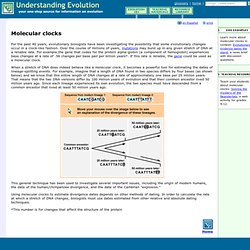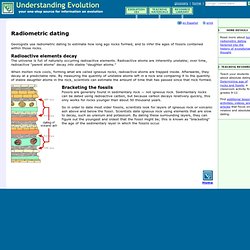

Molecular clocks. Molecular clocks For the past 40 years, evolutionary biologists have been investigating the possibility that some evolutionary changes occur in a clock-like fashion.

Over the course of millions of years, mutations may build up in any given stretch of DNA at a reliable rate. For example,the gene that codes for the protein alpha-globin (a component of hemoglobin) experiences base changes at a rate of .56 changes per base pair per billion years*. Stratigraphy. Stratigraphy In the example at left, we can deduce that the oldest rocks are those that are cut through by other rocks.

The next oldest rocks are those that are "doing the cutting" through the oldest rocks, and the youngest rocks lie on top of these layers and are not cut through at all. By making careful observations, we can detect these interruptions in the vertical pattern and use them to get more information about the relative ages of different layers. By studying and comparing strata from all over the world, we can date rocks relative to one another. Radiometric dating. Radiometric dating Geologists use radiometric dating to estimate how long ago rocks formed, and to infer the ages of fossils contained within those rocks.

Radioactive elements decay The universe is full of naturally occurring radioactive elements. Radioactive atoms are inherently unstable; over time, radioactive "parent atoms" decay into stable "daughter atoms. " When molten rock cools, forming what are called igneous rocks, radioactive atoms are trapped inside.